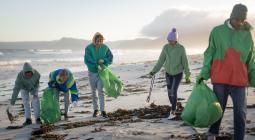This New York City island was once a military base. Now it’s becoming a climate solutions hub – in pictures
Governors Island, a 172-acre island in New York Harbor only accessible by ferry, attracts nearly a million visitors each year. More recently, it has evolved into an educational hub and incubator for solutions to facing the city’s climate and environmental challenges
Between lower Manhattan’s iconic skyscrapers and Brooklyn’s buzzing waterfront lies Governors Island, a 172-acre island in New York Harbor only accessible by ferry, seen here in July. Originally used by the Lenape tribe for seasonal hunting and fishing, Governors Island later became a military outpost and army headquarters before being sold to New York City and the state. It was officially opened to the public in 2005.
With its expansive green lawns, panoramic views, food vendors, and rotating art installations, the island now attracts nearly a million visitors each year. More recently, it has evolved into an educational hub and incubator for solutions to facing the city’s climate and environmental challenges.
Through a pilot program headed by the Trust for Governor’s Island, innovators and companies receive funding and space to launch their ideas and test them in the real world. Projects include Seaweed City, a non-profit that started in Newtown Creek in 2021 with the goal of connecting communities to local waterways by involving them in the growing and harvesting of kelp, while exploring its potential for innovative uses. Shanjana Mahmud (right), 41, founder and co-executive director of Seaweed City, seen here with volunteers pulling kelp from their recent harvest to the shore.
Seaweeds like kelp, shown here being rinsed by volunteers, offer a nature-based solution to water quality challenges. They help purify the water and create vital marine habitats. “It’s remarkable how the default solutions for improving the city’s waterways are often energy-intensive, engineered, and not conducive to marine life,” said Mahmud. “By contrast, seaweed restoration supports biodiversity in a natural and sustainable way.”
“It’s been amazing doing something hands-on outside of an academic setting,” said Manal Bawazir, 27, a biology major and first-time volunteer seen here arranging the kelp to dry which will then be preserved on site and ready to be processed. The harvested seaweeds can then be processed into soil amendment and biomaterials.
Seaweed City aims to establish seaweed gardens across all five boroughs in collaboration with local community organizations. With full-time jobs in addition to their work at Seaweed City, Mahmud and partner Luke Eddins identified their main challenge as expanding their organizational capacity as well as securing sustainable funding to support full-time staff.
The island also hosts long-term tenants working on environmental solutions, such as the Billion Oyster Project, which launched in 2014, with the goal of restoring one billion oysters in New York Harbor by 2035 while engaging the community. Alana Norwood-Hollis visited Governor’s Island for the first time from Brooklyn to volunteer with the oyster project on a recent day in July. “I wanted to volunteer, and I’m happy I started here,” she said.
Built by staff and volunteers, these reef balls will be installed in the harbor at multiple restoration sites to encourage oyster larvae attachment. A healthy oyster population can improve water quality, while the reefs serve as a natural habitat for marine life and a natural defense against erosion and sea level rise. So far, they’ve reintroduced 150 million oysters into the water.
On a recent July morning, volunteers helped transfer oyster shells through a tumbler that cleans and sorts the shells onto palettes, which are then placed in the hatchery for oyster incubation. The oysters come from restaurants across the city and are left for a year to be ‘cleaned’ by sunshine, bugs, rain and other natural processes before oyster larvae are introduced.
Other long-term tenants include an urban composting center by Earth Matters, a nonprofit. As part of the island’s zero waste mission, the facility processes all of the food scraps and landscape debris generated on the island and turns it into nutrient-rich compost that is directly returned to the soil on and off the island to community gardens and parks in the city. Volunteers are seen here setting up pads of woodchips and landscape debris from the island to prep for a drop off of food scraps.
Open to the public, the site aims to show how communities can participate in small-scale composting within an urban environment. Charlie Bayrer, one of the founders, is seen here holding the finished compost, organic matter that can be used as fertilizer in garden soil. “It’s the magic of the transformation,” said Bayrer about what keeps him returning to the island to share the knowledge of this ancient practice.
Earth Matter’s work heavily relies on education and volunteer activities, such as caring for the goats, which are brought from a dairy farm each summer. Their nitrogen-rich manure is added to the composting process.
A once-abandoned military chapel, formerly known as Our Lady Star of the Sea, was renovated and opened in 2024 to host the island’s climate week and other events. Now known as Building 309, people are seen here lining up for a Climate Solutions Showcase event in June.
The first year of the climate pilot program in June 2023 focused on water, a theme for which the island is an expert. Now in its second year, the program has invited companies working in the circular economy, a model that aims shifting from a linear model of resource extraction, product creation, and waste to methods that eliminate waste and pollution, maximizing resource use through the principles of reduce, reuse, recycle, and repair. Attendees are seen here
Manuel Benitez Ruiz shares his ideas for embedding vegetation into building materials, marketed as low-carbon concrete, designed to enhance air quality and reduce extreme heat during public demonstrations of the Climate Solutions Showcase on the island in April. His company, Plantaer, will test its living concrete façade technology on the island in the coming year.
One of the inspirations for this year’s theme of reusing and recycling is a solar-powered micro factory from Circular Economy manufacturing. It chops up plastic waste like laundry detergent bottles and then uses a low energy system to form new things. Governors Island has a grant-funded project to collaborate on the manufacture of park furniture.
Made from plastic film canisters, these planters are among the products that Circular Economy manufacturing hopes to continue creating from plastic waste. Led by Barent Roth, a designer and professor at the Parsons School of Design, he saw a huge need for industrial designers to design specifically to solve environmental problems.“Too often designers were just making stylistic changes and not worrying about the massive amount of waste that was being generated, and I saw us as being part of the problem when we could be part of the solution. So I just kind of dedicated my career to it.”
Cover photo: An aerial view of Governors Island in New York City in July. Photograph: Thalia Juarez/The Guardian



